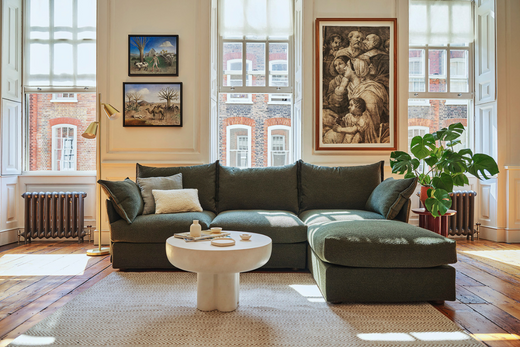2025 Interior Design Trend: Biophilic Design

2025 Interior Design Trend: Biophilic Design
“Biophilic” is the word to describe humans’ desire to connect with other forms of life in nature. And so, in 2025, we’re bringing the outside in.
What is the Biophilic Design trend?
The Biophilic Design trend takes inspiration from organic materials like stone, clay, wood and sand to create calm, grounded spaces.
Designers and homeowners are incorporating more earthy tones in their colour palettes and choosing patterns and textures that echo those we find in nature.

Where did the Biophilic Design trend come from?
Nature has always been present in interior design. But this Biophilic Design Trend feels like an evolution of the Botanical trend we've been loving for the past few years that featured lush, verdant greens, botanical prints, and an abundance of indoor plants.
But where the Botanical trend took inspiration from leaves and greenery, the Biophilic Design trend is inspired by more subtle, organic tones. This goes hand-in-hand with the ‘Dark and Earthy’ trend we predicted in our 2025 colour report.
“Well-being is also a big factor of this trend” says our Head of Interior Design, Kelly Collins “Many of us seek to create spaces that foster a connection to nature. This approach not only lifts your mood, it evokes a sense of calm.”

How to apply the Biophilic Design trend in your home
You only need to step outside to feel inspired—there are so many ways to recreate this indoor-outdoor trend in your home.

Fill your home with dark and earthy colours
In lieu of bright green, opt for rich, warmer tones like earthy browns and deep, murky greens. They balance nicely with sandy neutrals and mushroom greys, that together, create a palette that feels soothing and sophisticated.
These colour palettes lend themselves well to the tonal layering trend, where you combine different tones of the same colour within one space. For example: Dark wood, a brown sofa and soft furnishings in Pantone’s 2025 Colour of the Year Mocha Mousse.

Layer textures
Texture plays as significant a role in this trend as colour. And especially if you are keeping within a tonal palette, different textures are necessary.
Linens, wools and woven textiles bring a more organic feel to sofas, chairs and soft furnishings. Where burl wood furniture, jute rugs and stone accents add contrast to your space with a harder edge. That contrast is something that’s always present in natural landscapes.

Accessorise with nature
Houseplants still have their place in this trend—especially those with darker leaves like Raven ZZ or rubber plants. But you can also incorporate other natural elements in your home.
Style a console table with a huge vase and an oversized branch or use rustic, woven baskets for storage. Stack and empty fireplace with chopped logs or top an ottoman footstool with a natural stone or marble tray.

Frame the outdoors
If you’re lucky to have a garden and big, sprawling windows or patio doors, like this hidden garden home, you have all the foundations of a Biophilic space. But is there a way that you can turn these entryways into more of a feature? For example, adding some lights to your garden, and placing a cosy armchair and footstool next to a large window so you can admire nature no matter the time or weather. Perhaps you’d add some more plants and trees to your garden—so that every window and door becomes a living picture frame. You can still bring the outdoors in, without literally bringing something from the outdoors inside.

The Biophilic Trend is great because most of the work is done for you. Nature never gets it wrong when it comes to design. It’s no wonder people want to replicate its beauty in their homes.
→ See more of our interior design trend predictions for 2025
Share
Tags
- 2024 Interiors
- Interior Trends
- translated-DE





